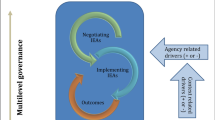Abstract
Environmental degradation is increasingly causing cross-border displacement of people, but countries have formed no treaties to facilitate collaboration on the issue. When is such collaboration feasible, and how should environmental displacement treaties be designed? We present a game-theoretic analysis. In our model, countries first decide on ratifying a treaty, and doing so commits them to helping other countries that face cases of environmental degradation in the future. The equilibrium analysis suggests that treaty formation is easier under conditions of mutual vulnerability than if some countries are at a greater risk of environmental degradation than others. Our most important finding is that contrary to the received wisdom, treaties imposing stringent demands on countries are easier to form than treaties that are easy to comply with. We also examine the benefits of using displacement treaties to build capacity for cooperation. We illustrate the utility of the analysis with a discussion of the Kampala Convention on environmental displacement and consider the potential for future treaty formation in Sub-Saharan Africa and Oceania.


Similar content being viewed by others
Notes
In this expression, the payoff from being the victim is higher than from being the non-victim. All results hold if we add a large negative constant to the payoff for being a victim, for constants do not shape strategic behavior by standard arguments based on the expected utility theorem.
Empirically, calculating this level of symmetry requires detailed information about relative environmental vulnerabilities and other conditions. Our model is not sufficiently detailed for such a calibration exercise.
Again, this expression suggests that the non-victim benefits from a more severe environmental crisis in the victim country. Our results continue to hold if a penalty multiplied by θ is imposed on both countries.
See http://www.internal-displacement.org/kampala-convention. Accessed on September 13, 2013.
See https://www.cia.gov/library/publications/the-world-factbook/geos/bc.html and https://www.cia.gov/library/publications/the-world-factbook/geos/sf.html. Accessed on August 30, 2012.
See http://climate.gov.ki/Kiribati_climate_change_strategies.html#apm1_2. Accessed September 5, 2012.
See http://www.mfat.govt.nz/Countries/Pacific/Kiribati.php. Accessed August 31, 2012.
See http://www.mfat.govt.nz/Countries/Pacific/Kiribati.php. Accessed August 31, 2012.
See http://www.immigration.govt.nz/community/stream/employ/rse. Accessed August 31, 2012.
Abbreviations
- DTP:
-
Directive on temporary protection
- EDP:
-
Environmentally displaced person
- IDP:
-
Internally displaced person
- IMMACT:
-
United States Immigration Act
- SPNE:
-
Subgame perfect Nash equilibrium
- WVI:
-
Wheeler Vulnerability Index
References
Abbott, K. W., & Snidal, D. (2000). Hard and soft law in international governance. International Organization, 54(3), 421–456.
Abbott, K. W., Keohane, R. O., Moravcsik, A., Slaughter, A. M., & Snidal, D. (2000). The concept of legalization. International Organization, 54(3), 401–419.
Barrett, S. (2003). Environment and statecraft: The strategy of environmental treaty-making. New York: Oxford University Press.
Boano, C., Zetter, R., & Morris, T. (2008). Environmentally displaced people: Understanding the linkages between environmental change, livelihoods and forced migration, Forced Migration Policy Briefing 1, Refugee Studies Centre. Oxford: Oxford University.
Cartwright, A. (no date) Coastal vulnerability in the context of climate change: A South African perspective, Mimeo.
Dai, X. (2002). Information systems in treaty regimes. World Politics, 54(4), 405–436.
Downs, G. W., Rocke, D. M., & Barsoom, P. N. (1996). Is the good news about compliance good news about cooperation?. International Organization, 50(3), 379–406.
Evalue Research (2010). Final evaluation report of the recognised seasonal employer policy (2007–2009), IMSED Research, Department of Labour, New Zealand Government.
Falstrom, D. Z. (2001). Stemming the flow of environmental displacement: Creating a convention to protect persons and preserve the environment. Colorado Journal of International Environmental Law and Policy, 1, 1–19.
Guzman, A. T. (2008). How international law works: A rational choice theory. New York: Oxford University Press.
Lopez, A. (2007). The protection of environmentally-displaced persons in international law. Environmental Law, 37(2), 365–409.
Makhema, M. (2009). Social protection for refugees and asylum seekers in the Southern Africa Development Community (SADC), world Bank Social Protection and Labor Discussion Paper 0906.
Marcoux, C., & Urpelainen, J. (2012). Capacity, not constraints: A theory of North-South regulatory cooperation. Review of International Organizations, 7(4), 399–424.
McAdam, J. (2011). Swimming against the tide: Why a climate change displacement treaty is not the answer. International Journal of Refugee Law, 23(1), 2–27.
Milner, H. V. (1997). Interests, institutions, and information: Domestic politics and international relations. Princeton: Princeton University Press.
Moberg, K. K. (2009). Extending refugee definitions to cover environmentally displaced persons displaces necessary protection. Iowa Law Review, 94, 1107–1146.
Omari, K. (2010). Climate change vulnerability and adaptation preparedness in southern Africa: A case study of Botswana, report for Heinrich Böll Stiftung.
Putnam, R. D. (1988). Diplomacy and domestic politics: The logic of two-level games. International Organization, 44(3), 427–460.
Rosendorff, B. P. (2005). Stability and rigidity: Politics and design of the WTO’s dispute settlement procedure. American Political Science Review, 99(3), 389–400.
Roy, K., Kumar, U., Mehedi, H., Sultana, T., & Ershad, D. (2009). Initial damage assessment report of cyclone AILA with focus on Khulna district, Unnayan Onneshan-Humanity Watch.
Urpelainen, J. (2010). Regulation under economic globalization. International Studies Quarterly, 54(4), 1099–1121.
Von Stein, J. (2005). Do treaties constrain or screen? selection bias and treaty compliance. American Political Science Review, 99(4), 611–622.
Wheeler, D. (2011). Quantifying vulnerability to climate change: Implications for adaptation assistance, Center for Global Development, Working Paper 240.
Williams, A. (2008). Turning the tide: Recognizing climate change refugees in international law. Law and Policy, 30(4), 502–529.
Acknowledgments
We thank Sung Eun Kim, Greg Wannier, Patrick Woolsey, Alice Xu, the anonymous reviewers, and Joyeeta Gupta for helpful comments on a previous draft.
Author information
Authors and Affiliations
Corresponding author
Appendices
Mathematical Appendix
This appendix contains the mathematical analysis and extensions.
1.1 Equilibrium
The unique pair of equilibrium strategies is the following:
-
1.
In the subgame without a treaty, the victim plays s k = θ and the non-victim plays s l = 0
-
2.
In the subgame with a treaty, the victim plays s k = θ and the non-victim plays s l = αθ
-
3.
At the treaty ratification stage, country i ratifies the treaty if and only if \(\pi_{i} \int\limits_{0}^{1}f(\theta)\frac{1}{2}\theta^{2}{\rm d}\theta < \pi_{i} \int\limits_{0}^{1}f(\theta) \left[\frac{1}{2}\theta^{2} + \alpha\theta^{2} \right] {\rm d}\theta + \left(1 - \pi_{i}\right) \int\limits_{0}^{1} f(\theta) \left[\frac{1}{2}\alpha^{2}\theta^{2}- \alpha\theta^{2} \right] {\rm d}\theta\).
Consider first the subgame without a treaty. The first-order conditions for k, l are
each with equality whenever s k , s l > 0. This completes the characterization of the first class of subgames.
Consider now the subgame with treaty. First, s l > θ can be rejected as strictly dominated strategy. Thus, the first-order conditions are
each with equality whenever s k , s l > 0. This completes the characterization of the second class of subgames.
For the treaty ratification stage, note that the inequality given above has the expected payoff from non-ratification on the left and the expected payoff from ratification on the right side.
1.2 Proofs
To prove the first proposition, let \(\pi_{A} \rightarrow \frac{1}{2}\). Each country’s expected payoff from the treaty is now arbitrarily close to the other country’s payoff. This payoff is given by
Without a treaty, each country’s payoff is
The marginal payoff from treaty formation is thus
Combining terms and simplifying, we are left with
This expression is strictly positive, so the claim follows.
Now, we prove the second proposition. The less vulnerable country B receives a payoff of
where \(\pi_{B} \leq \frac{1}{2}\). Differentiating with respect to α, we obtain the effect of changing treaty bindingness α on country B’s payoff:
The first term within an integral is strictly positive; the second term within an integral is strictly negative. Given the continuity of the expected value, it is clear that the value of the derivate is strictly increasing in π B . To show that a unique threshold exists, it suffices to consider the extreme cases π B = 0 ⇔ π A = 1 and \(\pi_{B} = \frac{1}{2} \Leftrightarrow pi_{A} = \frac{1}{2}\). With π B = 0, the expression is strictly negative because the first term disappears. With \(\pi_{B} = \frac{1}{2}\), the expression simplifies to
This is a strictly positive expression, so the claim follows.
1.3 Parametric example: uniform distribution
When θ is uniformly distributed on the [0,1] interval, country is expected payoff without treaty formation is given by:
The expected payoff with treaty formation is
simplifying to
The marginal payoff from treaty formation is obtained by subtracting the latter from the former. Simple algebraic manipulation shows that country i is exactly indifferent regarding the treaty whenever
Extension: capacity building under mutual interest
To see that each country i’s payoff without a treaty does not depend on γ, simply note that it does not appear in the payoff equation. Consider now the case with a treaty. To see that country i’s payoff must increase, note that γ only appears in the term \(-\gamma\frac{1}{2}s_{i}^{2}\), where i = k, l. As γ decreases, the value of this term increases for any given s i . Thus, country i’s equilibrium payoff must increase whenever γ is decreased.
Extension: victim’s obligations
If the victim k plays s * k = θ, as in the original model, the reputational cost from \(-\alpha\theta\cdot \left(\theta-s_{k}\right)\) is zero. With this term disappearing, the victim’s optimal strategy and behavior must remain unchanged.
Rights and permissions
About this article
Cite this article
Subramanian, N., Urpelainen, J. Addressing cross-border environmental displacement: when can international treaties help?. Int Environ Agreements 14, 25–46 (2014). https://doi.org/10.1007/s10784-013-9233-2
Accepted:
Published:
Issue Date:
DOI: https://doi.org/10.1007/s10784-013-9233-2




